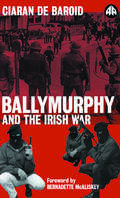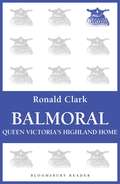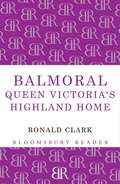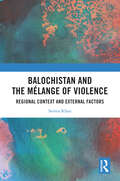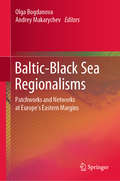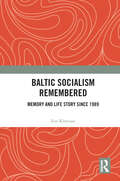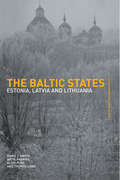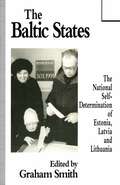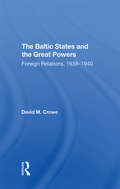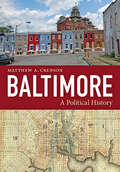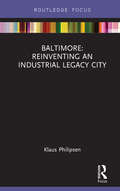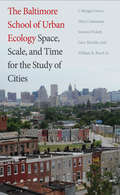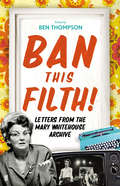- Table View
- List View
Ballot Box China: Grassroots Democracy in the Final Major One-Party State (Asian Arguments)
by Kerry BrownSince 1988, China has undergone one of the largest, but least understood experiments in grassroots democracy. Across 600,000 villages in China, with almost a million elections, some three million officials have been elected.The Chinese government believes that this is a step towards `democracy with Chinese characteristics'. But to many involved in them, the elections have been mired by corruption, vote-rigging and cronyism.This book looks at the history of these elections, how they arose, what they have achieved and where they might be going, exploring the specific experience of elections by those who have taken part in them - the villagers in some of the most deprived areas of China.
Ballots and Bullets: The Elusive Democratic Peace
by Joanne GowaThere is a widespread belief, among both political scientists and government policymakers, that "democracies don't fight each other." Here Joanne Gowa challenges that belief. In a thorough, systematic critique, she shows that, while democracies were less likely than other states to engage each other in armed conflicts between 1945 and 1980, they were just as likely to do so as were other states before 1914. Thus, no reason exists to believe that a democratic peace will survive the end of the Cold War. Since U.S. foreign policy is currently directed toward promoting democracy abroad, Gowa's findings are especially timely and worrisome. Those who assert that a democratic peace exists typically examine the 1815-1980 period as a whole. In doing so, they conflate two very different historical periods: the pre-World War I and post-World War II years. Examining these periods separately, Gowa shows that a democratic peace prevailed only during the later period. Given the collapse of the Cold War world, her research calls into question both the conclusions of previous researchers and the wisdom of present U.S. foreign policy initiatives. By re-examining the arguments and data that have been used to support beliefs about a democratic peace, Joanne Gowa has produced a thought-provoking book that is sure to be controversial.
Ballots and Bullets: The Elusive Democratic Peace (PDF)
by Joanne GowaThere is a widespread belief, among both political scientists and government policymakers, that "democracies don't fight each other." Here Joanne Gowa challenges that belief. In a thorough, systematic critique, she shows that, while democracies were less likely than other states to engage each other in armed conflicts between 1945 and 1980, they were just as likely to do so as were other states before 1914. Thus, no reason exists to believe that a democratic peace will survive the end of the Cold War. Since U.S. foreign policy is currently directed toward promoting democracy abroad, Gowa's findings are especially timely and worrisome. Those who assert that a democratic peace exists typically examine the 1815-1980 period as a whole. In doing so, they conflate two very different historical periods: the pre-World War I and post-World War II years. Examining these periods separately, Gowa shows that a democratic peace prevailed only during the later period. Given the collapse of the Cold War world, her research calls into question both the conclusions of previous researchers and the wisdom of present U.S. foreign policy initiatives. By re-examining the arguments and data that have been used to support beliefs about a democratic peace, Joanne Gowa has produced a thought-provoking book that is sure to be controversial.
Ballymurphy and the Irish War
by Ciaran de Baroid‘One of the most remarkable books to emerge from the Northern conflict. I can’t recall any other book which gives the reader the same accessibility to the streets of Belfast.’ Irish Post*BR**BR*‘A thrilling people’s history of Belfast’s most famous housing estate which will be remembered as one of the classic books to emerge from the Troubles.’ Andersonstown News
Balmoral: Queen Victoria's Highland Home
by Ronald ClarkFirst published in 1981, this is Ronald Clark's engagingly readable account of Queen Victoria's relationship with "Our dear Balmoral" and the life that went on there. The biography of Balmoral begins with the first visit to Scotland of the young Queen Victoria and her husband Prince Albert in 1842. Five years later, while bad weather envelops the Royal party in western Scotland, the son of the Queen's physician, convalescing in Old Balmoral, reports blazing sunshine from Upper Deeside. The death of his host shortly afterwards opens the way for the Royal acquisition of the Balmoral estate and the building of the new Castle in 1853-55. In the period up to Albert's death in 1861 Balmoral becomes the setting for many of the Royal couple's happiest moments as they revel in the beauties of the scenery, relish the picturesque pageantry of Highland life, enjoy their incognito expeditions into the surrounding country, and - in Albert's case - discover a passionate enthusiasm for deer-stalking. After the Prince Consort's death Balmoral becomes a mausoleum of memories, but also a source of strength enabling the Queen to survive her devastating loss. About the time of the Golden Jubilee of 1887 there is an Indian summer, with members of the Queen's extensive family rallying round and dances and entertainments displacing some of the black-crepe gloom. In 1896 there is the colorful visit of the Tsar, with his wife and daughter. The closing section links Victorian Balmoral with the life of the Castle today.
Balmoral: Queen Victoria's Highland Home (PDF)
by Ronald W. ClarkFirst published in 1981, this is Ronald Clark's engagingly readable account of Queen Victoria's relationship with "Our dear Balmoral" and the life that went on there. The biography of Balmoral begins with the first visit to Scotland of the young Queen Victoria and her husband Prince Albert in 1842. Five years later, while bad weather envelops the Royal party in western Scotland, the son of the Queen's physician, convalescing in Old Balmoral, reports blazing sunshine from Upper Deeside. The death of his host shortly afterwards opens the way for the Royal acquisition of the Balmoral estate and the building of the new Castle in 1853-55. In the period up to Albert's death in 1861 Balmoral becomes the setting for many of the Royal couple's happiest moments as they revel in the beauties of the scenery, relish the picturesque pageantry of Highland life, enjoy their incognito expeditions into the surrounding country, and - in Albert's case - discover a passionate enthusiasm for deer-stalking. After the Prince Consort's death Balmoral becomes a mausoleum of memories, but also a source of strength enabling the Queen to survive her devastating loss. About the time of the Golden Jubilee of 1887 there is an Indian summer, with members of the Queen's extensive family rallying round and dances and entertainments displacing some of the black-crepe gloom. In 1896 there is the colorful visit of the Tsar, with his wife and daughter. The closing section links Victorian Balmoral with the life of the Castle today. 9781448202331 9781448202331
Balochistan and the Mélange of Violence: Regional Context and External Factors
by Seema KhanThis book presents a comprehensive analysis of the intricate security situation prevailing in Balochistan. It explores and establishes correlations between the internal structural vulnerabilities and fault lines of the Pakistani state with the external influences exerted on the region. Employing a rigorous examination of both primary and secondary data, the volume critically examines the multifaceted nature of organised violence in Balochistan. In addition to separatist movements, the presence of religious militancy and cross-border terrorism is thoroughly examined. The book delves into the external involvement of regional and global powers in the intricate tapestry of violence within Balochistan, thereby shedding light on the emerging geopolitical landscape and the corresponding power dynamics in the region. It also analyses how the implementation of largescale developmental initiatives, particularly facilitated by China under the auspices of the China–Pakistan Economic Corridor (CPEC), has elevated the geostrategic significance of Balochistan while simultaneously entangling it in the vortex of regional power politics. This volume will be of interest to scholars and researchers specializing in geopolitics, International Relations, and South Asian studies.
Balochistan and the Mélange of Violence: Regional Context and External Factors
by Seema KhanThis book presents a comprehensive analysis of the intricate security situation prevailing in Balochistan. It explores and establishes correlations between the internal structural vulnerabilities and fault lines of the Pakistani state with the external influences exerted on the region. Employing a rigorous examination of both primary and secondary data, the volume critically examines the multifaceted nature of organised violence in Balochistan. In addition to separatist movements, the presence of religious militancy and cross-border terrorism is thoroughly examined. The book delves into the external involvement of regional and global powers in the intricate tapestry of violence within Balochistan, thereby shedding light on the emerging geopolitical landscape and the corresponding power dynamics in the region. It also analyses how the implementation of largescale developmental initiatives, particularly facilitated by China under the auspices of the China–Pakistan Economic Corridor (CPEC), has elevated the geostrategic significance of Balochistan while simultaneously entangling it in the vortex of regional power politics. This volume will be of interest to scholars and researchers specializing in geopolitics, International Relations, and South Asian studies.
The Baltic: A Regional Future?
by John FitzmauriceThis book examines the historical, political, cultural and economic links between the littoral states of the Baltic sea and seeks to analyse what it is that has created a strong sense of regional identity within the area, that has enabled the area to survive conflicts external to the region that have been projected onto the region. Thus, this sense of identity now forms the basis for future regional cooperation that could be a significant factor for stability in the region.
Baltic-Black Sea Regionalisms: Patchworks and Networks at Europe's Eastern Margins
by Olga Bogdanova Andrey MakarychevThis edited volume focuses on various forms of regionalism and neighborhoods in the Baltic-Black Sea area. In the light of current reshaping of borderlands and new geopolitical and military confrontations in Europe’s eastern margins, such as the annexation of Crimea and the war in Donbas, this book analyzes different types and modalities of regional integration and region-making from a comparative perspective. It conceptualizes cooperative and conflictual encounters as a series of networks and patchworks that differently link and relate major actors to each other and thus shape these interconnections as domains of inclusion and exclusion, bordering and debordering, securitization and desecuritization. This peculiar combination of geopolitics, ethnopolitics and biopolitics makes the Baltic-Black Sea trans-national region a source of inspiring policy practices, and, in the light of new security risks, a matter of increased concern all over Europe. The contributors from various disciplines cover topics such as cultural and civilizational spaces of belonging and identity politics, the rise of right-wing populism, region building under the condition of multiple security pressures, and the influence and regional strategies of different external powers, including the EU, Russia, and Turkey, on cross- and trans-regional relations in the area.
Baltic Socialism Remembered: Memory and Life Story since 1989
by Ene KõresaarWhat does it mean to tell a life story?How is one’s memory of communism shaped by family, profession, generation and religion?Do post-communist Baltic states embrace similar memories?The Baltic states represent not only a geographical but also a mnemonic region. The mental maps of people who live on this territory are shaped by memories of Soviet socialism. Baltic Socialism Remembered captures the workings of the memory of diverse groups of people who inhabit the region: teachers, officials, young people, women, believers. It comes as no surprise that their memories do not overlap, but often contradict to other groups and to official narratives. Baltic Socialism Remembered is a rare attempt to engage with the mnemonic worlds of social groups and individuals rather than with memory politics and monumental history. The contributors try to chart unpredictable ways in which public and national memory affect individual memory, and vice versa. Understanding complexity and diversity of memory workings in such compact region as the Baltic states will enable a more nuanced policy-making.This book was originally published as a special issue of Journal of Baltic Studies.
Baltic Socialism Remembered: Memory and Life Story since 1989
by Ene KõresaarWhat does it mean to tell a life story?How is one’s memory of communism shaped by family, profession, generation and religion?Do post-communist Baltic states embrace similar memories?The Baltic states represent not only a geographical but also a mnemonic region. The mental maps of people who live on this territory are shaped by memories of Soviet socialism. Baltic Socialism Remembered captures the workings of the memory of diverse groups of people who inhabit the region: teachers, officials, young people, women, believers. It comes as no surprise that their memories do not overlap, but often contradict to other groups and to official narratives. Baltic Socialism Remembered is a rare attempt to engage with the mnemonic worlds of social groups and individuals rather than with memory politics and monumental history. The contributors try to chart unpredictable ways in which public and national memory affect individual memory, and vice versa. Understanding complexity and diversity of memory workings in such compact region as the Baltic states will enable a more nuanced policy-making.This book was originally published as a special issue of Journal of Baltic Studies.
The Baltic States: Estonia, Latvia and Lithuania (Postcommunist States and Nations #3)
by Thomas Lane Artis Pabriks Aldis Purs David J. SmithSince the end of the Cold War there has been an increased interest in the Baltics. The Baltic States brings together three titles, Estonia, Latvia and Lithuania, to provide a comprehensive and analytical guide integrating history, political science, economic development and contemporary events into one account. Since gaining their independence, each country has developed at its own pace with its own agenda and facing its own obstacles. The authors examine the tensions accompanying a post-communist return to Europe after the long years of separation and how each country has responded to the demands of becoming a modern European state. Estonia was the first of the former Soviet republics to enter membership negotiations with the European Union in 1988 and is a potential candidate for the next round of EU expansion in 2004. Lithuania and Latvia have also expressed their desire for future membership of NATO and the EU.
The Baltic States: Estonia, Latvia and Lithuania (Postcommunist States and Nations)
by Thomas Lane Artis Pabriks Aldis Purs David J. SmithSince the end of the Cold War there has been an increased interest in the Baltics. The Baltic States brings together three titles, Estonia, Latvia and Lithuania, to provide a comprehensive and analytical guide integrating history, political science, economic development and contemporary events into one account. Since gaining their independence, each country has developed at its own pace with its own agenda and facing its own obstacles. The authors examine the tensions accompanying a post-communist return to Europe after the long years of separation and how each country has responded to the demands of becoming a modern European state. Estonia was the first of the former Soviet republics to enter membership negotiations with the European Union in 1988 and is a potential candidate for the next round of EU expansion in 2004. Lithuania and Latvia have also expressed their desire for future membership of NATO and the EU.
The Baltic States: The National Self-Determination of Estonia, Latvia and Lithuania
by Graham SmithThe Baltic States examines the struggles of the Baltic peoples for national self-determination. It is divided into two parts. Part one explores their nationalist awakening, how the realization of national self-determination during the inter-war years of independent statehood manifested itself, and the impact that fifty years of subsequent incorporation into the Soviet Union has had on Baltic politics and national cultures. Part two examines the nationalist reawakening in the late 1980s, the re-establishment of Baltic national self-governance in 1990-91 and the problems that these countries now face as sovereign entities.
The Baltic States And The Great Powers: Foreign Relations, 1938-1940
by David CroweThis is the first complete account of the diplomatic relations and military steps leading to Estonia's, Latvia's, and Lithuania's forcible absorption into the USSR in 1940. David Crowe—making use of recently opened archival sources—traces the Baltic states' relations with the Soviet Union, Germany, Poland, Great Britian, France and with one another from 1917-1940. He starts with an overview of 1917-1936 and then offers a detailed description of the diplomatic maneuvering that marked Europe's collective slide toward war. Crowe covers the Sudeten and Memel crises involving German communities in 1938, the German-Soviet Pact in August 1939, the mutual assistance pacts between the Baltic States and the USSR, the Baltic German migration, Soviet use of Estonia's military installations during their assault on Finland, and the subsequent Soviet occupation of the Baltic states. The story ends with the election of new, Soviet-sponsored legislatures that sought admission into the USSR as Soviet republics in 1940—a step that most Western countries never recognized, and one that the Baltic states finally reversed when they regained their independence fifty-one years later in August 1991.
The Baltic States And The Great Powers: Foreign Relations, 1938-1940
by David CroweThis is the first complete account of the diplomatic relations and military steps leading to Estonia's, Latvia's, and Lithuania's forcible absorption into the USSR in 1940. David Crowe—making use of recently opened archival sources—traces the Baltic states' relations with the Soviet Union, Germany, Poland, Great Britian, France and with one another from 1917-1940. He starts with an overview of 1917-1936 and then offers a detailed description of the diplomatic maneuvering that marked Europe's collective slide toward war. Crowe covers the Sudeten and Memel crises involving German communities in 1938, the German-Soviet Pact in August 1939, the mutual assistance pacts between the Baltic States and the USSR, the Baltic German migration, Soviet use of Estonia's military installations during their assault on Finland, and the subsequent Soviet occupation of the Baltic states. The story ends with the election of new, Soviet-sponsored legislatures that sought admission into the USSR as Soviet republics in 1940—a step that most Western countries never recognized, and one that the Baltic states finally reversed when they regained their independence fifty-one years later in August 1991.
Baltimore: A Political History
by Matthew A. CrensonCharm City or Mobtown? People from Baltimore glory in its eccentric charm, small-town character, and North-cum-South culture. But for much of the nineteenth century, violence and disorder plagued the city. More recently, the 2015 death of Freddie Gray in police custody has prompted Baltimoreans;¢;‚¬;€?and the entire nation;¢;‚¬;€?to focus critically on the rich and tangled narrative of black;€“white relations in Baltimore, where slavery once existed alongside the largest community of free blacks in the United States.Matthew A. Crenson, a distinguished political scientist and Baltimore native, examines the role of politics and race throughout Baltimore's history. From its founding in 1729 up through the recent past, Crenson follows Baltimore's political evolution from an empty expanse of marsh and hills to a complicated city with distinct ways of doing business. Revealing how residents at large engage (and disengage) with one another across an expansive agenda of issues and conflicts, Crenson shows how politics helped form this complex city's personality.Crenson provocatively argues that Baltimore's many quirks are likely symptoms of urban underdevelopment. The city's longtime domination by the general assembly;¢;‚¬;€?and the corresponding weakness of its municipal authority;¢;‚¬;€?forced residents to adopt the private and extra-governmental institutions that shaped early Baltimore. On the one hand, Baltimore was resolutely parochial, split by curious political quarrels over issues as minor as loose pigs. On the other, it was keenly attuned to national politics: during the Revolution, for instance, Baltimoreans were known for their comparative radicalism. Crenson describes how, as Baltimore and the nation grew, whites competed with blacks, slave and free, for menial and low-skill work. He also explores how the urban elite thrived by avoiding, wherever possible, questions of slavery versus freedom;¢;‚¬;€?just as wealthier Baltimoreans, long after the Civil War and emancipation, preferred to sidestep racial controversy. Peering into the city's 300-odd neighborhoods, this fascinating account holds up a mirror to Baltimore, asking whites in particular to reexamine the past and accept due responsibility for future racial progress.
Baltimore: A Political History
by Matthew A. CrensonCharm City or Mobtown? People from Baltimore glory in its eccentric charm, small-town character, and North-cum-South culture. But for much of the nineteenth century, violence and disorder plagued the city. More recently, the 2015 death of Freddie Gray in police custody has prompted Baltimoreans;¢;‚¬;€?and the entire nation;¢;‚¬;€?to focus critically on the rich and tangled narrative of black;€“white relations in Baltimore, where slavery once existed alongside the largest community of free blacks in the United States.Matthew A. Crenson, a distinguished political scientist and Baltimore native, examines the role of politics and race throughout Baltimore's history. From its founding in 1729 up through the recent past, Crenson follows Baltimore's political evolution from an empty expanse of marsh and hills to a complicated city with distinct ways of doing business. Revealing how residents at large engage (and disengage) with one another across an expansive agenda of issues and conflicts, Crenson shows how politics helped form this complex city's personality.Crenson provocatively argues that Baltimore's many quirks are likely symptoms of urban underdevelopment. The city's longtime domination by the general assembly;¢;‚¬;€?and the corresponding weakness of its municipal authority;¢;‚¬;€?forced residents to adopt the private and extra-governmental institutions that shaped early Baltimore. On the one hand, Baltimore was resolutely parochial, split by curious political quarrels over issues as minor as loose pigs. On the other, it was keenly attuned to national politics: during the Revolution, for instance, Baltimoreans were known for their comparative radicalism. Crenson describes how, as Baltimore and the nation grew, whites competed with blacks, slave and free, for menial and low-skill work. He also explores how the urban elite thrived by avoiding, wherever possible, questions of slavery versus freedom;¢;‚¬;€?just as wealthier Baltimoreans, long after the Civil War and emancipation, preferred to sidestep racial controversy. Peering into the city's 300-odd neighborhoods, this fascinating account holds up a mirror to Baltimore, asking whites in particular to reexamine the past and accept due responsibility for future racial progress.
Baltimore: Reinventing an Industrial Legacy City (Built Environment City Studies)
by Klaus PhilipsenBaltimore: Reinventing an Industrial Legacy City is an exploration into the reinvention, self-reflection and boosterism of US legacy cities, taking Baltimore as the case study model to reveal the larger narrative. Author Klaus Philipsen investigates the modern urban condition and the systemic problems involved with adapting metropolitan regions into equitable and sustainable communities, covering topics such as growth, urban sprawl, the depletion of cities, social justice, smart city and open data, transportation, community development, sustainability and diversity. Baltimore’s proximity to the US capital, combined with its industrial past, presents the optimum viewpoint to investigate these challenges and draw parallels with cities across the world.
Baltimore: Reinventing an Industrial Legacy City (Built Environment City Studies)
by Klaus PhilipsenBaltimore: Reinventing an Industrial Legacy City is an exploration into the reinvention, self-reflection and boosterism of US legacy cities, taking Baltimore as the case study model to reveal the larger narrative. Author Klaus Philipsen investigates the modern urban condition and the systemic problems involved with adapting metropolitan regions into equitable and sustainable communities, covering topics such as growth, urban sprawl, the depletion of cities, social justice, smart city and open data, transportation, community development, sustainability and diversity. Baltimore’s proximity to the US capital, combined with its industrial past, presents the optimum viewpoint to investigate these challenges and draw parallels with cities across the world.
The Baltimore School of Urban Ecology: Space, Scale, and Time for the Study of Cities
by J. Morgan Grove Mary Cadenasso Steward T. Pickett Gary E. Machlis William R. BurchThe first “urban century” in history has arrived: a majority of the world’s population now resides in cities and their surrounding suburbs. Urban expansion marches on, and the planning and design of future cities requires attention to such diverse issues as human migration, public health, economic restructuring, water supply, climate and sea-level change, and much more. This important book draws on two decades of pioneering social and ecological studies in Baltimore to propose a new way to think about cities and their social, political, and ecological complexity that will apply in many different parts of the world. Readers will gain fresh perspectives on how to study, build, and manage cities in innovative and sustainable ways.
Ban This Filth!: Letters From the Mary Whitehouse Archive
by Ben ThompsonIn 1964, Mary Whitehouse launched a campaign to fight what she called the 'propaganda of disbelief, doubt and dirt' being poured into homes through the nation's radio and television sets. Whitehouse, senior mistress at a Shropshire secondary school, became the unlikely figurehead of a mass movement for censorship: the National Viewers' and Listeners' Association, now Mediawatch-uk.For almost forty years, she kept up the fight against the programme makers, politicians, pop stars and playwrights who she felt were dragging British culture into a sewer of blasphemy and obscenity. From Doctor Who ('Teatime brutality for tots') to Dennis Potter (whose mother sued her for libel and won) to the Beatles - whose Magical Mystery Tour escaped her intervention by the skin of its psychedelic teeth - the list of Mary Whitehouse's targets will read to some like a nostalgic roll of honour.Caricatured while she lived as a figure of middle-brow reaction, Mary Whitehouse was held in contempt by the country's intellectual elite. But were some of the dangers she warned of more real than they imagined? Ben Thompson's selection of material from her extraordinary archive shows Mary Whitehouse's legacy in a startling new light. From her exquisitely testy exchanges with successive BBC Directors General, to the anguished screeds penned by her television and radio vigilantes, these letters reveal a complex and combative individual, whose anxieties about culture and morality are often eerily relevant to the age of the internet. 'A fantastic read . . . I can't recommend it highly enough.' Lauren Laverne, BBC Radio 6 Music
Bananas, Beaches and Bases Making Feminist Sense of International Politics (PDF)
by Cynthia EnloeIn this brand new radical analysis of globalization, Cynthia Enloe examines recent events—Bangladeshi garment factory deaths, domestic workers in the Persian Gulf, Chinese global tourists, and the UN gender politics of guns—to reveal the crucial role of women in international politics today.
Banded Vegetation Patterning in Arid and Semiarid Environments: Ecological Processes and Consequences for Management (Ecological Studies #149)
by David J. Tongway J. C. Menaut Christian Valentin B. Walker Josiane SeghieriAerial photography has revealed the striking, widespread phenomenon of repeating patterns of vegetation in more arid areas of the world. Two interdependent phases, bands of dense and sparse vegetation, alternate in the landscape. This volume synthesizes half a century's accumulated knowledge of both theoretical and applied landscape function from a variety of these regions. It covers structure, dynamics, and methods of study, as well as disturbances to these landscapes and relevant management issues. Various chapters discuss the role of modeling in answering questions about the origins and complex processes of banded landscapes.


